DRYWOOD TERMITES
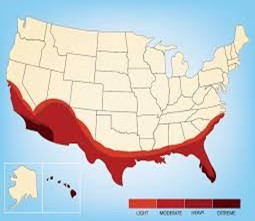
Drywood termites live entirely in dry, sound wood. Unlike subterranean termites, they require no connection with the soil or an above-ground moisture source.
Drywood Termite colonies are small in comparison to subterranean termite colonies. A mature colony may only contain a few thousand individuals.
They are a social insect, meaning they live in colonies and manifest three characteristics: group integration,
division of labor and overlap of generations.
King and Queen:
The king and queen are the royal pair of the colony. After two years, the colony is still quite small. Over time, the size of the queen’s ovaries increases and the abdomen swells. The abdomen appears striped because the swelling stretches the abdominal membranes so that each individual segment becomes visible. The king, however, does not change much in appearance, although he does shrink a bit, and looks virtually the same as when he first dropped his wings.
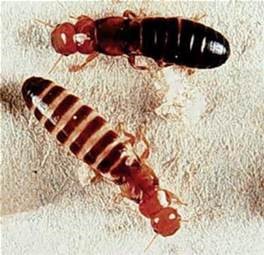
Nymphs or Immature Termites:
In a drywood termite colony, there aren’t any true worker termites.
Instead, the nymphs do the labor of a traditional “worker caste”.
Their main duties are to excavate feeding galleries in the wood, tend to the eggs and young, and feed the queen and king. The nymphs will eventually become either reproductive forms or soldiers.
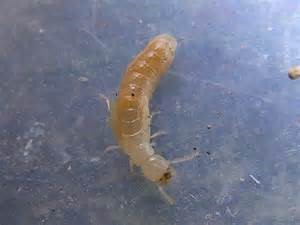
Soldiers:
The soldiers have an enlarged, reddish-brown head. The mandibles are large and black with two prominent teeth visible on the inner margin of the left mandible.
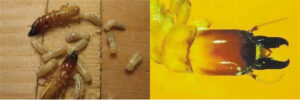
ALATES (swarmers)
After several years, when a drywood termite colony matures, winged alates are produced that leave the colony to establish new colonies.
Alates are winged male and female termites. If successful in mating, some will become royal pairs. The kings and queens of new colonies.
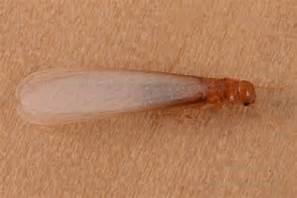
Drywood termites spend their entire lives inside wood and because of this, their galleries fill with their fecal matter or “frass”. They construct round “kickout holes” in infested wood, through which their fecal pellets are ejected from the galleries. These pellets accumulate in small piles below the kickout holes.
Drywood termite pellets are small, hard and oval. They have rounded ends and six concavely depressed sides. The color of the pellets will vary, depending on the type of wood they are infesting.
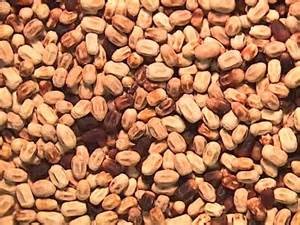
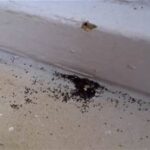
Drywood termite damage is different than that of subterranean termites. No mud tunnels are produced and there is no evidence of soil in the feeding areas.
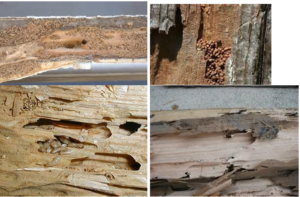
Drywood termites excavate large, smooth galleries across and with the wood grain, consuming both the spring and summer wood. The galleries usually contain their fecal pellets.
The basic premise behind prevention is by denying termites access to your home. Preventing drywood termite infestation is more difficult than preventing subterranean species as the outside of homes have many sites where termites may enter. However, certain preventative measures can be effective.
Remove all potential sources of outdoor infestation such as stored lumber, firewood, scrap lumber and dead trees or shrubbery. Screen attic or foundation vents with bug screen to prevent drywood termite alates from entering those areas.
Drywood termites will not enter wood that has a sound coat of paint. Before painting, seal any cracks, crevices and joints with wood putty. Also remove any rotted or decayed wood and replace with new wood prior to painting.